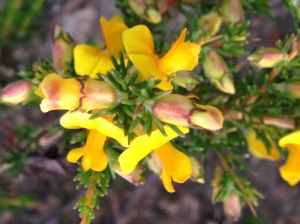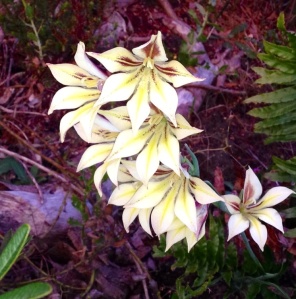Our friends and family who follow this blog or drop in from time to time know that I spend far too much of my time on planes and away from our farm. My work as a management consultant is part time, but sometimes very intense. This has been an busy couple of weeks, working on a project that distracts me from the normal concerns of life and pulls my focus to what matters, in other words, the work that earns the money, in part at least, to pay for it all.
The project is winding up, although it took most of the weekend to finish the work for a demanding client. The last report went through to Johannesburg as the sun started to set and on went the running shoes, up went the dogs tails and off we ran.
Mostly I like to run in the mornings; it gets exercise out of the way and is such a satisfying way to start the day. Yet there is something extraordinary about the evening run. Especially on an evening like this. The sky was perfectly clear, the light diffused with damp. For January it is not hot, warm, certainly but not hot. The wind has dropped and the stillness on the mountain is like a deep breath taken, not yet released. The intensity of the light comes across in this picture taken above an alley of hakias and pines that serve as a windbreak with the setting sun behind them.

We have magnificent buzzards, Forest Buzzards we think, nesting in the trees along the drive. They are migratory and territorial and return year after year. The two of them perch on trees either side of the dam and screech gleefully, joyfully at one another. There is nothing quite like the call of an African raptor. We think one of them has a sense of humour. He perches on a tree at the top of the drive, and dives off as we pass, flying along the valley. Maebh chases him, imagining he might come into reach. At the bottom of the valley he turns, and flies back up again, close to the road, where Maebh joyfully pounds along beside him. Its so funny to watch and begs the question, do birds have a sense of humour? Probably not; but sometimes you wonder.
The Christmas berry or Chironia baccifera is in full flower now. I’ll post it later in the year, covered in glorious red berries. It’s a lovely shrub, I wonder if I could take cuttings and grow it in the garden? unlikely given my ungreen fingers.

Chironia baccifera
I can’t believe how stunning the red heath, or Erica abietina is looking all over the farm. Where other flowers retreat in the hot weather, and the fecundity seems beaten down by the harsh light of the summer months, this plant defiantly produces it’s best flowers and looks magnificent.

Erica abietina, Red Heath is magnificent in the summer months
As we ran down the mountain I was conscious that it was hot and stopped to wait for the wolfhounds. I keep a close eye on them in the summer heat. I don’t want to lose one to a snake, or sudden dehydration, which happens in this part of the world. Here is Seamus catching up with us while Maebh keeps an anxious eye.

Maebh waits for Seamus in the hot evening light
Meanwhile this slightly bedraggled daisy-like thing seems to like the hot weather. On the north side of the farm there are quite a few of them, though they have proven strangely difficult to photograph in focus. This is about the best we can do. I think it’s Felicia aetheophica, which grows all year round.

Felicia aetheopica
As we ran down the mountain the sun set directly behind Table Mountain. If there are moments when I count my blessings, this definitely was one of the them. The light was amazing, the dogs had gone for a welcome break in Fox Pan and all was well with our world.

The sun sets behind Table Mountain, 60 km to the west of us

Two Irish Wolfhounds and Jemima Chew enjoy the cool water in Fox Pan
Just as I stopped to take this photo these little pea like flowers grabbed my attention. I think it’s a type of honeybush or Cyclopia, but I’m not sure which one. This is new and to my amazement means that we have still found a new flower on every single run.

Cyclopia or Honeybush





















